The rear or posterior deltoids (“delts”) are muscles nestled at the back of your shoulders. They help stabilize the shoulders and participate in movements of the arm about the shoulder joint. Training your rear delts is as important as training any other muscle for improving strength, size, and overall function.
While there are many ways to train the shoulders as a whole, incorporating exercises that directly target the muscles of the upper back, to include the rear delts, is likely a good idea for most. Our top-recommended rear delt exercises that we’ll cover today are: Pendlay/barbell row, wide grip lat pulldown, 1-arm dumbbell row, bent over dumbbell flyes, reverse pec deck fly, and face pulls.
Rear Delt Muscles Anatomy
The deltoid a triangular muscle that arises from the scapula (shoulder blade) and the clavicle (collarbone) and inserts into the humerus as part of the shoulder girdle. [1, 2] The shoulder girdle is made up of the proximal humerus, scapula, and clavicle. [3] In addition to the deltoid muscle, the shoulder girdle also encompasses the rotator cuff, trapezius and other periscapular stabilizing muscles, triceps, latissimus dorsi, and pectoralis major and minor. [4, 5, 6, 7, 8].
The deltoid is made up of three distinct sets of muscle fibers — anterior, middle (or acromial), and posterior. [9] Its base connects to the spine of the scapula and the lateral third of the clavicle.
The deltoid as a whole is a multifaceted muscle which has several roles, such as lifting the arm, rotating it externally, and stabilizing the movements of other muscles in your arm and back. Specifically, the posterior fibers of the deltoid muscle stabilizes shoulders and primarily aids the latissimus dorsi to extend the arm while walking.
What are the Best Rear Delt Exercises?
- Pendlay/Barbell Row: 3 to 4 sets of 6 to 10 repetitions
- Wide grip lat pulldown: 3 to 4 sets of 8 to 12 repetitions
- 1-arm dumbbell row: 3 to 4 sets of 8 to 12 repetitions
- Bent over dumbbell flyes: 2 to 4 sets of 10 to 15 repetitions
- Reverse pec deck fly: 2 to 4 sets of 10 to 15 repetitions
- Face pulls: 2 to 4 sets of 10 to 15 repetitions
Many people wonder whether different exercises produce different results. A research study comparing various upper-limb strength training exercises based on the electromyographic activity of the three portions of the deltoid muscle discovered the following: the anterior deltoid was activated in the same way during the smith machine shoulder press, bench press, and peck deck, but EMG activity was significantly higher in the smith machine shoulder press as opposed to during other exercises.
The middle (or acromial) deltoid had similar electrical activity during lateral raises, reverse pec deck, and seated row, whereas the posterior deltoid exhibited similar activity during reverse pec deck, incline lat pull-down, and seated row, and was much more activated in the reverse pec deck as opposed to during other exercises. [10]
Another study compared deltoid muscle electrical activity during multi- and single-joint exercises. The following exercises were included: the bench press, dumbbell fly, shoulder press, and lateral raise. The results suggest that the posterior fibers of the deltoid had a lot of electrical activity during the reverse pec deck (a single-joint exercise) compared to the seated row and inclined lateral pull-down (multi-joint exercises). Furthermore, the middle portion of the deltoid had the highest level of electrical activity during the reverse pec deck and the seated row as opposed to during the inclined lateral pull-down. Last but not least, the anterior portion of the deltoid was found to have relatively low levels of electrical activity during these exercises. [11]
That all being said, these studies and others investigating the electrical activity, e.g., “excitation” of the various fibers of the deltoid shouldn’t be taken as gospel. While the EMG differences are likely real, existing data doesn’t show that the differences are predictive of actual outcomes, e.g., differences in muscle size and strength when using one or more variation(s) over the other. In other words, it’s not clear that using EMG data alone to select an exercise yields better results than making sure the exercise actually loads the muscle or muscles of interest.
Last but not least, keep in mind that to target your rear delts as efficiently as possible, make sure that you aren’t unintentionally allowing other muscle groups to take over the movements; so don’t forget to mindfully engage the right muscles. [12]
1. Pendlay/Barbell Row
The barbell row, also known as the bent-over row, strengthens your shoulders, back, and arms. It’s one of the first exercises that lifters typically learn in order to train the muscles of the upper back. Research comparing the standing bent-over row, the inverted row, and the standing 1-arm cable row suggests that the bent-over row exercise engages the large muscles of both the upper and lower back. [13]
The Pendlay row is named after Glenn Pendlay, a US Olympic weightlifting coach who created it. It’s an upper back exercise and a variation of the regular barbell row that starts and ends at the floor. Still, both the barbell row and the Pendlay row work the same muscles: lats, trapezius, rhomboids, rear delts, and biceps.
Both exercises are useful in their own right — when it comes to choosing which one to do, it’s mostly personal preference. The Pendlay row has a more consistent range of motion compared to the traditional barbell row, as it starts and ends on the floor. That said, both exercises are likely to generate similar results.
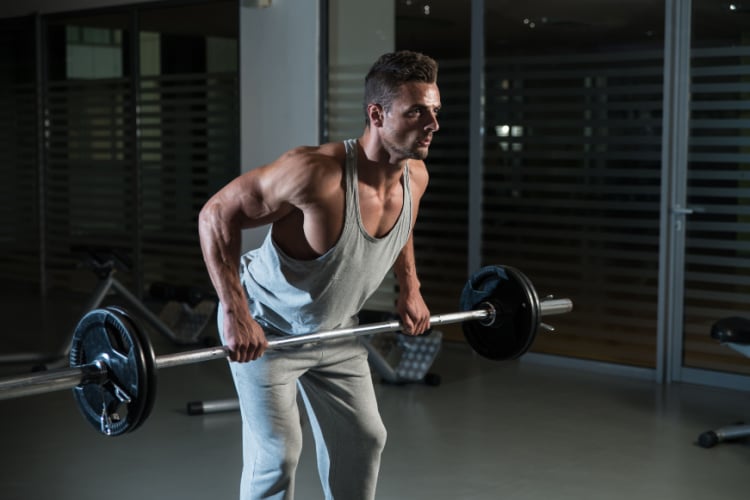
Movement category: Primary or Secondary
Programming: 3 to 4 sets of 6 to 10 repetitions.
Weight: Use a weight that leaves you 2 to 3 reps short of failure, e.g. RPE 7 to 8.
Pendlay/Barbell Row Instructions
While the differences between the barbell row and the Pendlay row are quite subtle, they still matter. The biggest difference between the two is the beginning position — to do a barbell row, you begin with the bar just below your knees, that is, your torso is positioned at ~45 degrees relative to the ground; to do a Pendlay row, you start from the ground, which means you need to bend over more at the hip forward to grab the bar, so your torso is fairly horizontal, likely near-parallel to the ground.
To do the barbell row:
- Stand with your legs hip-width apart with the middle of your feet right below the bar. Ensure your torso is at ~45 degrees relative to the ground.
- Bend over and pick up the bar in a medium grip.
- Hinge your hips back and lift the barbell until the weights reach knee height.
- Engage your core and maintain a neutral spine.
- Lift the weight upwards to reach your lower chest and squeeze your shoulder blades together.
- Lower the weight until your arms are fully stretched.
The Pendlay row has a similar setup as the barbell row, however, the body position differs. To perform the exercise:
- Stand with your feet hip-width apart, with the middle of your feet just below the bar.
- Bend over and pick up the bar with a shoulder-width grip. Your torso should be pretty close to parallel to the ground.
- Keeping your hips, lower back, and legs relatively still, pull the bar to your chest using your arms and upper back, squeezing your shoulder blades together. The bar should touch you near the sternum.
- Lower the bar to the ground.
Pro Tip:
Whether you go with the Pendlay row or the barbell row, stay mindful of your form. Keep rowing the barbell until your elbows pass the torso and maintain a tight upper back throughout the activity.
2. Wide Grip Lat Pulldown
The wide grip lat pulldown is a seated exercise using a high pulley machine where you pull a hanging bar toward yourself until the bar gets below your chin and near your chest. As you reverse the motion and the bar upwards, maintain control in the movement rather than allowing it to slingshot back. It’s a variation of the lat pull down that uses a wider grip placement, which shifts some of the tension away from your biceps and mid back onto your lats. Besides your lats, the wide grip lat pulldown works your posterior deltoid and other muscles of the upper back.
There are many studies exploring the muscle activation during numerous lat pulldown variations. [14, 15, 16, 17, 18, 19] That said, there’s one which examines the differences in muscle activations among distinct grip widths in the overhand pull down, the most common variation of the activity. [16, 17] Namely, the muscle activation was observed with four distinct grip variations — wide vs. narrow, and pronated vs. supinated grip. The findings showed similar muscle activation in the latissimus dorsi, the middle trapezius, and the biceps brachii between narrow and wide grips. [16]
Another piece of research suggests a higher electrical activity of the latissimus dorsi with a wide grip as opposed to other grips using 10RM loads. [17] Yet another study suggests that there are no major differences in the muscle activation for latissimus dorsi, biceps brachii, infraspinatus, and trapezius while doing 6RM in the overhand lat pulldown with medium, narrow, and wide grip widths. The lifted 6RM load was lower when a wide grip was used as opposed to small/medium grip, though. [20]
That said, there is no definitive difference between wide grip and standard lat pulldowns in terms of effectiveness — different muscle groups are likely accentuated by different grip placements, which is why the variation you choose should be in line with your current fitness objectives. Again, we wouldn’t place too much emphasis on EMG studies for selecting exercises. Equipment-wise, you need a lat pulldown cable machine setup.
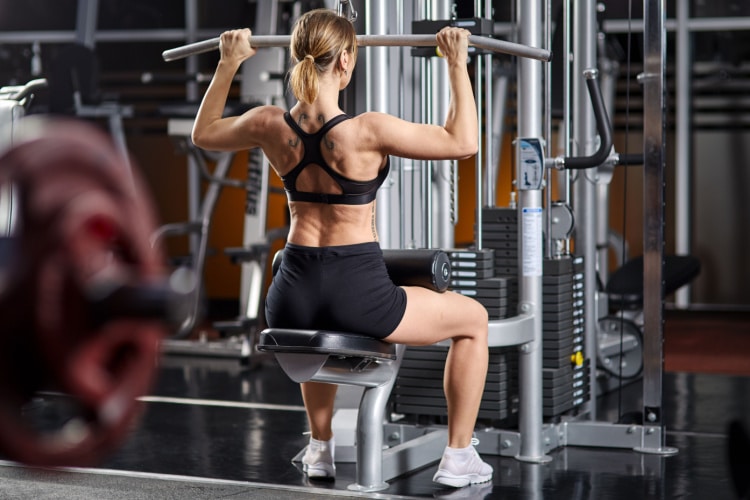
Movement category: Secondary
Programming: 3 to 4 sets of 8 to 12 repetitions.
Weight: Use a weight that leaves you 2 to 3 reps short of failure, e.g. RPE 7 to 8.
Wide Grip Lat Pulldown Instructions
- Sit on the pulldown seat with both feet flat on the ground. Check the bar’s height — if necessary, adjust the height by lengthening/shortening the cable. Adjust the machine so that your thighs fit under the leg pads. Choose your preferred weight.
- Stand up and grab the bar with an overhand grip. Place your hands wider than shoulder-width apart. Sit down again.
- Lean back a bit but keep a relatively vertical spine and both feet flat on the ground. Now, pull the bar down toward your upper chest by pulling your elbows down and back.
- When the bar reaches just below chin height, gradually bring it back to the beginning position by straightening your arms.
Pro Tip:
Don’t let the head jut forward while you pull.
3. 1-Arm Dumbbell Row
The 1-arm dumbbell row is a multi-joint or compound exercise used to build strength and muscle mass. Certain studies have found that single-joint exercises are better for increased muscle hypertrophy, as they’re easier to learn, requiring less skill and technique to perform properly. [21, 22] That said, other experts claim that multi-joint exercises are the ones that maximize muscle strength, as they allow for more weight to be lifted. [23, 24] Another piece of research analyzing these claims concluded that the selection between single-joint and multi-joint exercises should depend on individual preferences, equipment availability, movement specifications, and time constraints. [25] This echoes how we feel about exercise selection outside of sports-specific applications.
Rather than doing all single-joint (isolation) or all multi-joint (compound) exercises, both can be useful. Some studies suggest that both single-joint and multi-joint resistance exercises contribute to a similar strength increase in trained men. [26] Yet others have found that single-joint exercises result in higher hypertrophy of elbow flexors than multi-joint exercises after eight weeks of resistance training. [27] Both types of exercise have their place and most good training programs will include a combination of isolation and compound exercises.
In any case, the 1-arm dumbbell row works the lats, the back, shoulders, and arms, the trapezius, rhomboids, teres major and minor, deltoids, infraspinatus, biceps, brachialis, brachioradialis, and pecs. To perform the exercise, you need a dumbbell and a bench.
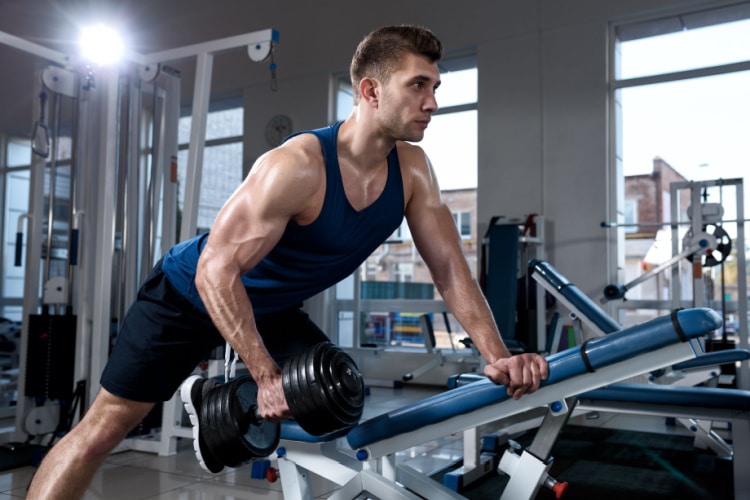
Movement category: Tertiary
Programming: 3 to 4 sets of 8 to 12 repetitions.
Weight: Use a weight that leaves you 2 to 3 reps short of failure, e.g. RPE 7 to 8.
1-Arm Dumbbell Row Instructions
- Place your left hand and knee, tucking your toes under, on a bench. Your right foot remains on the floor.
- Pick up a dumbbell in your right hand. Make sure your left hand is under your shoulder and knees are under your hips. Contract your core muscles to tighten your torso. Your back should be flat. Retract your scapulae without arching the lower back and maintain this position during the entire movement. Straighten your right arm, the one holding the dumbbell, toward the ground. This is your beginning position.
- Begin pulling the dumbbell slowly upward, as you flex your elbow and pull your upper arm backwards. Keep your arm close to the side of your body and resume pulling the dumbbell up until you’re not able to lift it any further without rotating the torso.
- Slowly lower the dumbbell to the starting position with a flat back and a retracted-shoulder position.
- Repeat an equal number of reps on both sides.
Pro Tip:
Aim to keep your back is flat during the exercise to put more tension on your lats and other muscles of the upper back. Also, don’t flare out your elbows. Keep them close to your side.
4. Bent Over Dumbbell Flyes
The bent over dumbbell flyes are an isolation exercise training the shoulder joint. That said, the actual movement trains more than one muscle group. It targets the rear deltoids, which are responsible for producing some of the force that enables you to raise your arms to the sides and back. [28] Additionally, this exercise works other upper back muscles, e.g. the rhomboids and infraspinatus. The former are significant for arm movement and help ensure shoulder stability; the latter plays a key role in shoulder extension. [29] There’s data indicating that the exercise engages the lateral or middle deltoids to some degree as well. [28, 30] The exercise works great with relatively lighter weights.
Movement category: Tertiary
Programming: 2 to 4 sets of 10 to 15 repetitions.
Weight: Use a weight that leaves you 0 to 2 reps short of failure, e.g. RPE 8 to 10.
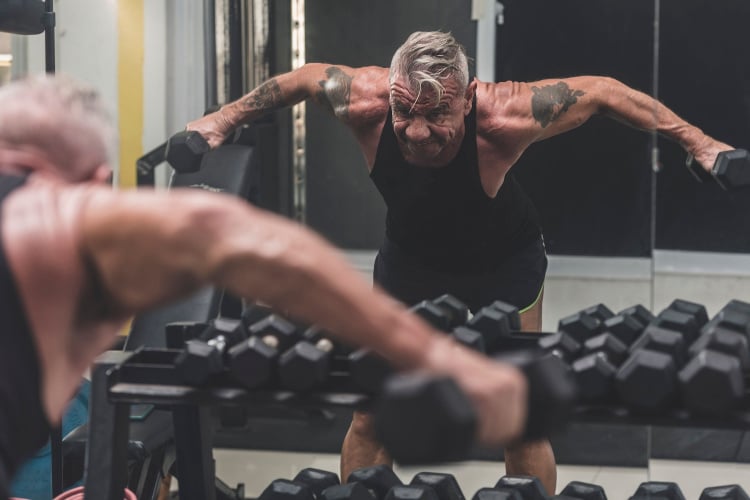
To perform the bent over dumbbell flyes, you need dumbbells.
Bent Over Dumbbell Flyes Instructions
- Grab a pair of dumbbells and stand tall. Place both feet about hip-width apart.
- Hinge over at the hip. Your torso should be relatively horizontal. Your arms should be hanging vertically with your elbows bent slightly.
- Keeping your elbows slightly flexed, pull the weights up and out to your sides in an arcing motion until your arms are nearly horizontal or parallel to the floor.
- Squeeze your upper back at the top of the movement for a moment, then lower the dumbbells to return to the starting position.
Pro Tip:
Make sure your torso’s as parallel to the floor as possible, as this will help you engage your rear delts as much as possible. Also, performing the exercise with a more upright torso increases the engagement of the rest of the back muscles. If you struggle to hinge forward to the optimal torso position, you can perform the activity seated instead.
5. Reverse Pec Deck Fly
Also known as the reverse fly, the reverse pec deck fly works as a machine analogue of the bent over dumbbell fly. Similar to bent over dumbbell flyes, the exercise primarily targets the rear deltoids, but also works other muscles of the upper back such as the trapezius (traps), rhomboids, teres major, and infraspinatus. To do the reverse pec deck fly, you need a pec deck machine, which is a machine made up of a seat, a chestpad, and two handles.
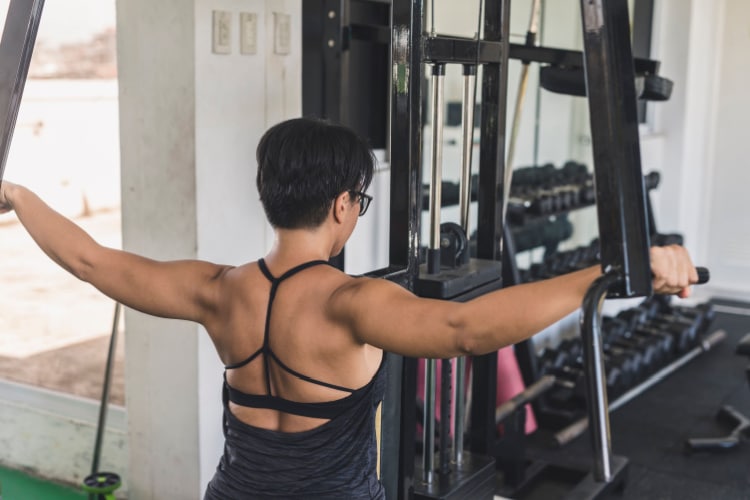
Programming: 2 to 4 sets of 10 to 15 repetitions.
Weight: Use a weight that leaves you 0 to 2 reps short of failure, e.g. RPE 8 to 10.
Reverse Pec Deck Fly Instructions
- Adjust the handles of the machine in the reverse fly setting.
- Sit and place your chest against the pad.
- The machine’s handles should be in front of your shoulders.
- Stretch both arms in front of you and grasp the handles using either an overhand or a neutral grip at shoulder height.
- Throughout the exercise, keep your elbows slightly bent.
- Open both arms in a reverse fly motion by contracting the rear delts.
- At the peak of the movement, your elbows should be behind your torso.
- Stop for a moment and contract your rear delts before you return to the starting position.
Pro Tip:
Doing the exercise using a neutral grip noticeably increases the activity of the posterior deltoid and the infraspinatus. [30]
6. Face Pulls
The face pull is a machine-based compound exercise mainly done to isolate the posterior deltoid muscles with the arms in external rotation. Face pulls are great for the rear delts, trapezius, and upper back muscles. [31] Although they primarily work the rear delts, they also target the traps, rhomboids, and the rotator cuff, as they work to stabilize the shoulder joint during this exercise.
Face pulls are considered by most serious lifters as an accessory movement to offset all the training that normally focuses on the anterior deltoid and chest. While there is no data to support a specific “push to pull” ratio, targeting the rear deltoids directly with this and similar exercises can provide adequate training stimulus to the posterior deltoids and upper back muscles while using relatively light weights, thereby likely reducing the amount of training fatigue generated. Equipment-wise, you need a cable pulley machine to do face pulls.
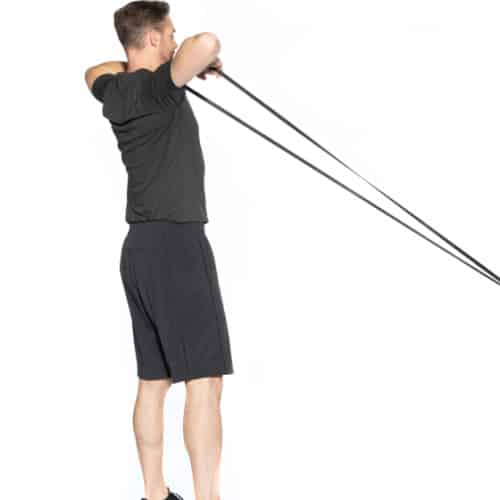
Movement category: Tertiary
Programming: 2 to 4 sets of 10 to 15 repetitions.
Weight: Use a weight that leaves you 0 to 2 reps short of failure, e.g. RPE 8 to 10.
Face Pull Instructions:
- Adjust the cable pulley machine so that the pulley system is positioned just above your head. Use the rope attachment with two hand-holds to do the exercise.
- Grab the handles with your hands and your palms facing in. Take a step back until both arms are completely stretched out, then engage your core and lean back a bit (your body should be positioned at an approximately 20-degree angle).
- Pull the rope toward you as much as necessary to begin lifting the weight from the stack. Engage both shoulders — roll them back to ensure proper posture (avoid having them hunched or rolled forward). This is the beginning position.
- Pull the handles toward your forehead.
- Flare your elbows outward to the sides of your body, thus, engaging your rear delts.
- Reverse the movement and gradually stretch both arms without letting your chest or shoulders roll forward as you stretch.
Pro Tip:
Make sure to focus on using a controlled tempo and on the squeeze at the end of the range of motion.
What are the Benefits of Exercising Your Rear Delt?
Helps to Relieve Back Pain
While many studies focused on core strengthening exercises for the management of chronic lower back pain have generated mixed or negative results, there is favorable evidence for resistance training. In a study of 45 adults with chronic lower back pain, patients involved in a 16-week, whole-body, progressive resistance training program using a variety of free weight and machine-based exercises demonstrated improvements in strength, pain reduction, and quality-of-life measures not seen in patients managed with aerobic training. [32]
Improved Strength
If you do 1-arm exercises such as the 1-arm dumbbell row, you’ll build strength in the arms as you make progress in the movement. [33] Then, there’s the barbell row exercise — one of the best rowing exercises to enhance strength and muscle development in the upper back, posterior shoulder girdle, and shoulder joint muscles. [34]
That said, when we discuss muscle strength, we shouldn’t only perceive a muscle’s capacity to create maximal force in the gym — actually, it’s been proven time and again that strength training boosts power, endurance, and speed along with muscle adaptation and development. [35, 36]
Improved (Physical) Health
Exercising in a way that increases muscle strength and size also lowers resting blood pressure and blood cholesterol, hence, reducing the danger of cardiovascular diseases. What’s more, there are indications that people who become stronger see significant health improvements as opposed to those who lift, but don’t grow their strength as much. [37, 38]
Engaging in physical activity is frequently linked with a lowered risk of numerous health problems, like cardiovascular disease, cardio-metabolic risk in teenagers, and type II diabetes in middle aged and elderly people. [39, 40, 41]
Reduced Joint Pain
Regular strength training helps reduce joint pain and debilitating conditions such as osteoarthritis. Affecting the hips, knees, and hands of middle aged and elderly people, osteoarthritis is a common condition linked to joint pain.
Consistent training is said to produce noticeable improvement in muscle strength, functional capacity, and pain score, even in cases with advanced disease. [42] Furthermore, beginning to exercise early on appears to not just reduce the loss of strength connected with the disease, but also slows down the development of osteoarthritis or completely stops it. [43]
Better Mental Health
Consistent training is said to alleviate the symptoms of mental health issues like anxiety or depression. This fortunate side effect occurs irrespective of whether the trainees grow their strength or not. However, the mechanism behind it is unknown at this time. [44, 45]
What’s more, strength training is said to improve a person’s sleep quality, which is a nice bonus, considering how important sleep is for our mental health. [46]
Conclusion
To sum up, the best rear delt exercises are:
- Pendlay/Barbell Row
- Wide grip lat pulldown
- 1-arm dumbbell row
- Bent over dumbbell flyes
- Reverse pec deck fly
- Face pulls
Training your rear delts is essential to building balanced shoulders in terms of stability, size, and strength. Now that you know the best rear delt exercises, sticking to an effective workout program is key. If you’re a beginner, you can try our Beginner Template; if you have some previous experience in training, opt for the Strength I Template; and if you’re a pro trainee, check out our Strength III Template.
That said, many people prefer an individual approach. If this is you, and you’re looking for an experienced team to guide you, we have you covered. Our team of professionals can tailor-make high-quality programs that suit your needs and goals. We’ll stay by your side as you move forward and modify your customized program according to your changing fitness needs.
But don’t take our word for it – hear what our other clients have to say. Log onto our forum and follow our social media accounts — Twitter, Instagram, and Facebook. You can also have a look at our growing YouTube channel, where we share fitness tips, discuss workout routines, provide how-to guides and much, much more – all backed by the latest research in sports medicine.
References
1. Hyland, S., Charlick, M., & Varacallo, M. (2022). Anatomy, Shoulder and Upper Limb, Clavicle. PubMed; StatPearls Publishing. https://pubmed.ncbi.nlm.nih.gov/30252246/
2. Cowan, P. T., Mudreac, A., & Varacallo, M. (2021). Anatomy, Back, Scapula. PubMed; StatPearls Publishing. https://pubmed.ncbi.nlm.nih.gov/30285370/
3. E, M., O, I., & M, V. (2022, August 8). Anatomy, Shoulder and Upper Limb, Humerus. PubMed. https://pubmed.ncbi.nlm.nih.gov/30521242/
4. Maruvada, S., Madrazo-Ibarra, A., & Varacallo, M. (2021). Anatomy, Rotator Cuff. PubMed; StatPearls Publishing. https://pubmed.ncbi.nlm.nih.gov/28722874/
5. Jeno, S. H., & Varacallo, M. (2022). Anatomy, Back, Latissimus Dorsi. PubMed; StatPearls Publishing. https://pubmed.ncbi.nlm.nih.gov/28846224/
6. Tiwana, M. S., Charlick, M., & Varacallo, M. (2022). Anatomy, Shoulder and Upper Limb, Biceps Muscle. PubMed; StatPearls Publishing. https://pubmed.ncbi.nlm.nih.gov/30137823/
7. McCausland, C., Sawyer, E., Eovaldi, B. J., & Varacallo, M. (2022). Anatomy, Shoulder and Upper Limb, Shoulder Muscles. PubMed; StatPearls Publishing. https://pubmed.ncbi.nlm.nih.gov/30521257/
8. Bordoni, B., & Varacallo, M. (2022). Anatomy, Head and Neck, Scalenus Muscle. PubMed; StatPearls Publishing. https://pubmed.ncbi.nlm.nih.gov/30085600/
9. Peterson, S. L., & Rayan, G. M. (2011). Shoulder and Upper Arm Muscle Architecture. The Journal of Hand Surgery, 36(5), 881–889. https://doi.org/10.1016/j.jhsa.2011.01.008
10. Botton, C. E., Wilhelm, E. N., Ughini, C. C., Pinto, R. S., & Lima, C. S. (2013). Electromyographical analysis of the deltoid muscle between different strength training exercises. Medicina Sportiva, 17(2), 67-71. https://doi.org/10.5604/17342260.1055261
11. Campos, Y. A. C., Vianna, J. M., Guimarães, M. P., Oliveira, J. L. D., Hernández-Mosqueira, C., da Silva, S. F., & Marchetti, P. H. (2020). Different Shoulder Exercises Affect the Activation of Deltoid Portions in Resistance-Trained Individuals. Journal of Human Kinetics, 75(1), 5–14. https://doi.org/10.2478/hukin-2020-0033
12. Snarr, R. L., Hallmark, A. V., Casey, J. C., & Esco, M. R. (2017). Electromyographical Comparison of a Traditional, Suspension Device, and Towel Pull-Up. Journal of Human Kinetics, 58, 5–13. https://doi.org/10.1515/hukin-2017-0068
13. Fenwick, C. M. J., Brown, S. H. M., & McGill, S. M. (2009). Comparison of Different Rowing Exercises: Trunk Muscle Activation and Lumbar Spine Motion, Load, and Stiffness. Journal of Strength and Conditioning Research, 23(2), 350–358. https://doi.org/10.1519/jsc.0b013e3181942019
14. Koyama, Y., Kobayashi, H., Suzuki, S., & Enoka, R. M. (2010). Enhancing the weight training experience: a comparison of limb kinematics and EMG activity on three machines. European Journal of Applied Physiology, 109(5), 789–801. https://doi.org/10.1007/s00421-010-1421-y
15. Lehman, G. J., Buchan, D., Lundy, A., Myers, N., & Nalborczyk, A. (2004). Variations in muscle activation levels during traditional latissimus dorsi weight training exercises: An experimental study. Dynamic Medicine, 3(1), 4. https://doi.org/10.1186/1476-5918-3-4
16. Lusk, S. J., Hale, B. D., & Russell, D. M. (2010). Grip Width and Forearm Orientation Effects on Muscle Activity During the Lat Pull-Down. Journal of Strength and Conditioning Research, 24(7), 1895–1900. https://doi.org/10.1519/jsc.0b013e3181ddb0ab
17. Signorile, J. F., Zink, A. J., & Szwed, S. P. (2002). A comparative electromyographical investigation of muscle utilization patterns using various hand positions during the lat pull-down. Journal of Strength and Conditioning Research, 16(4), 539–546. https://pubmed.ncbi.nlm.nih.gov/12423182/
18. Snyder, B. J., & Leech, J. R. (2009). Voluntary Increase in Latissimus Dorsi Muscle Activity During the Lat Pull-Down Following Expert Instruction. Journal of Strength and Conditioning Research, 23(8), 2204–2209. https://doi.org/10.1519/jsc.0b013e3181bb7213
19. Youdas, J. W., Amundson, C. L., Cicero, K. S., Hahn, J. J., Harezlak, D. T., & Hollman, J. H. (2010). Surface Electromyographic Activation Patterns and Elbow Joint Motion During a Pull-Up, Chin-Up, or Perfect-PullupTM Rotational Exercise. Journal of Strength and Conditioning Research, 24(12), 3404–3414. https://doi.org/10.1519/jsc.0b013e3181f1598c
20. Andersen, V., Fimland, M. S., Wiik, E., Skoglund, A., & Saeterbakken, A. H. (2014). Effects of Grip Width on Muscle Strength and Activation in the Lat Pull-Down. Journal of Strength and Conditioning Research, 28(4), 1135–1142. https://doi.org/10.1097/jsc.0000000000000232
21. Rutherford, O. M., & Jones, D. A. (1986). The role of learning and coordination in strength training. European Journal of Applied Physiology and Occupational Physiology, 55(1), 100–105. https://doi.org/10.1007/bf00422902
22. Chilibeck, P. D., Calder, A. W., Sale, D. G., & Webber, C. E. (1997). A comparison of strength and muscle mass increases during resistance training in young women. European Journal of Applied Physiology, 77(1-2), 170–175. https://doi.org/10.1007/s004210050316
23. American College of Sports Medicine. (2002). Progression Models in Resistance Training for Healthy Adults. Medicine and Science in Sports and Exercise, 34(2), 364–380. https://doi.org/10.1097/00005768-200202000-00027
24. American College of Sports Medicine. (2009). Progression Models in Resistance Training for Healthy Adults. Medicine & Science in Sports & Exercise, 41(3), 687–708. https://doi.org/10.1249/MSS.0b013e3181915670
25. Gentil, P., Soares, S., & Bottaro, M. (2015). Single vs. Multi-Joint Resistance Exercises: Effects on Muscle Strength and Hypertrophy. Asian Journal of Sports Medicine, 6(1). https://doi.org/10.5812/asjsm.24057
26. Brigato, F. A., Camargo, J. B. B. D., Ungaro, W. F. D., Germano, M. D., Marchetti, P. H., Aoki, M. S., Braz, T. V., & Lopes, C. R. (2020). Multi-joint vs. Single-joint Resistance Exercises Induce a Similar Strength Increase in Trained Men: A Randomized Longitudinal Crossover Study. International Journal of Exercise Science, 13(4). https://www.ncbi.nlm.nih.gov/pmc/articles/PMC7745915/
27. Mannarino, P., Matta, T., Lima, J., Simão, R., & Freitas de Salles, B. (2019). Single-Joint Exercise Results in Higher Hypertrophy of Elbow Flexors Than Multijoint Exercise. Journal of Strength and Conditioning Research, Publish Ahead of Print. https://doi.org/10.1519/jsc.0000000000003234
28. Bergquist, R., Iversen, V. M., Mork, P. J., & Fimland, M. S. (2018). Muscle Activity in Upper-Body Single-Joint Resistance Exercises with Elastic Resistance Bands vs. Free Weights. Journal of Human Kinetics, 61(1), 5–13. https://doi.org/10.1515/hukin-2017-0137
29. Williams, J. M., & Obremskey, W. (2019, February 13). Anatomy, Shoulder and Upper Limb, Infraspinatus Muscle. Nih.gov; StatPearls Publishing. https://www.ncbi.nlm.nih.gov/books/NBK513255/
30. Schoenfeld, B., Sonmez, R. G. T., Kolber, M. J., Contreras, B., Harris, R., & Ozen, S. (2013). Effect of Hand Position on EMG Activity of the Posterior Shoulder Musculature During a Horizontal Abduction Exercise. Journal of Strength and Conditioning Research, 27(10), 2644–2649. https://doi.org/10.1519/jsc.0b013e318281e1e9
31. Sakoma, Y., Sano, H., Shinozaki, N., Itoigawa, Y., Yamamoto, N., Ozaki, T., & Itoi, E. (2010). Anatomical and functional segments of the deltoid muscle. Journal of Anatomy, 218(2), 185–190. https://doi.org/10.1111/j.1469-7580.2010.01325.x
32. Sharma SK, Saiyad S, Bid DN. Role of latissimus dorsi and lower trapezius in chronic mechanical low back pain due to thoraco-lumbar dysfunction. Ind J Physioth Occupat Therapy. 2013;7(2):224. doi:10.5958/j.0973-5674.7.2.045
33. Valdes, O., Ramirez, C., Perez, F., Garcia‐Vicencio, S., Nosaka, K., & Penailillo, L. (2020). Contralateral effects of eccentric resistance training on immobilized arm. Scandinavian Journal of Medicine & Science in Sports, 31(1), 76–90. https://doi.org/10.1111/sms.13821
34. Ronai, P. (2017). The Barbell Row Exercise. ACSMʼs Health & Fitness Journal, 21(2), 25–28. https://doi.org/10.1249/fit.0000000000000278
35. Andersen V, Prieske O, Stien N, Cumming K, Solstad TEJ, Paulsen G, van den Tillaar R, Pedersen H, Saeterbakken AH. Comparing the effects of variable and traditional resistance training on maximal strength and muscle power in healthy adults: A systematic review and meta-analysis. J Sci Med Sport. 2022 Dec;25(12):1023-1032. doi: 10.1016/j.jsams.2022.08.009. Epub 2022 Aug 28. PMID: 36130847.
36. Balabinis CP, Psarakis CH, Moukas M, Vassiliou MP, Behrakis PK. Early phase changes by concurrent endurance and strength training. J Strength Cond Res. 2003 May;17(2):393-401. doi: 10.1519/1533-4287(2003)017<0393:epcbce>2.0.co;2. PMID: 12741884.
37. Igarashi, Yutaka. Effects of Differences in Exercise Programs With Regular Resistance Training on Resting Blood Pressure in Hypertensive Adults: A Systematic Review and Meta-Analysis. Journal of Strength and Conditioning Research 37(1):p 253-263, January 2023. | DOI: 10.1519/JSC.0000000000004236
38. Jansson AK, Chan LX, Lubans DR, Duncan MJ, Plotnikoff RC. Effect of resistance training on HbA1c in adults with type 2 diabetes mellitus and the moderating effect of changes in muscular strength: a systematic review and meta-analysis. BMJ Open Diabetes Res Care. 2022 Mar;10(2):e002595. doi: 10.1136/bmjdrc-2021-002595. PMID: 35273011; PMCID: PMC8915309.
39. Srikanthan, P., Horwich, T. B., & Tseng, C. H. (2016). Relation of Muscle Mass and Fat Mass to Cardiovascular Disease Mortality. American Journal of Cardiology, 117(8), 1355–1360. https://doi.org/10.1016/j.amjcard.2016.01.033
40. Burrows, R., Correa-Burrows, P., Reyes, M., Blanco, E., Albala, C., & Gahagan, S. (2017). Low muscle mass is associated with cardiometabolic risk regardless of nutritional status in adolescents: A cross-sectional study in a Chilean birth cohort. Pediatric Diabetes, 18(8), 895–902. https://doi.org/10.1111/pedi.12505
41. Son, J. W., Lee, S. S., Kim, S. R., Yoo, S. J., Cha, B. Y., Son, H. Y., & Cho, N. H. (2017). Low muscle mass and risk of type 2 diabetes in middle-aged and older adults: findings from the KoGES. Diabetologia, 60(5), 865–872. https://doi.org/10.1007/s00125-016-4196-9
42. Turner MN, Hernandez DO, Cade W, Emerson CP, Reynolds JM, Best TM. The Role of Resistance Training Dosing on Pain and Physical Function in Individuals With Knee Osteoarthritis: A Systematic Review. Sports Health. 2020 Mar/Apr;12(2):200-206. doi: 10.1177/1941738119887183. Epub 2019 Dec 18. PMID: 31850826; PMCID: PMC7040944.
43. Kristensen J, Franklyn-Miller A. Resistance training in musculoskeletal rehabilitation: a systematic review. Br J Sports Med. 2012 Aug;46(10):719-26. doi: 10.1136/bjsm.2010.079376. Epub 2011 Jul 26. PMID: 21791457.
44. Gordon BR, McDowell CP, Lyons M, Herring MP. The Effects of Resistance Exercise Training on Anxiety: A Meta-Analysis and Meta-Regression Analysis of Randomized Controlled Trials. Sports Med. 2017 Dec;47(12):2521-2532. doi: 10.1007/s40279-017-0769-0. PMID: 28819746.
45. Gordon BR, McDowell CP, Hallgren M, Meyer JD, Lyons M, Herring MP. Association of Efficacy of Resistance Exercise Training With Depressive Symptoms: Meta-analysis and Meta-regression Analysis of Randomized Clinical Trials. JAMA Psychiatry. 2018 Jun 1;75(6):566-576. doi: 10.1001/jamapsychiatry.2018.0572. PMID: 29800984; PMCID: PMC6137526.
46. Kovacevic A, Mavros Y, Heisz JJ, Fiatarone Singh MA. The effect of resistance exercise on sleep: A systematic review of randomized controlled trials. Sleep Med Rev. 2018 Jun;39:52-68. doi: 10.1016/j.smrv.2017.07.002. Epub 2017 Jul 19. PMID: 28919335.